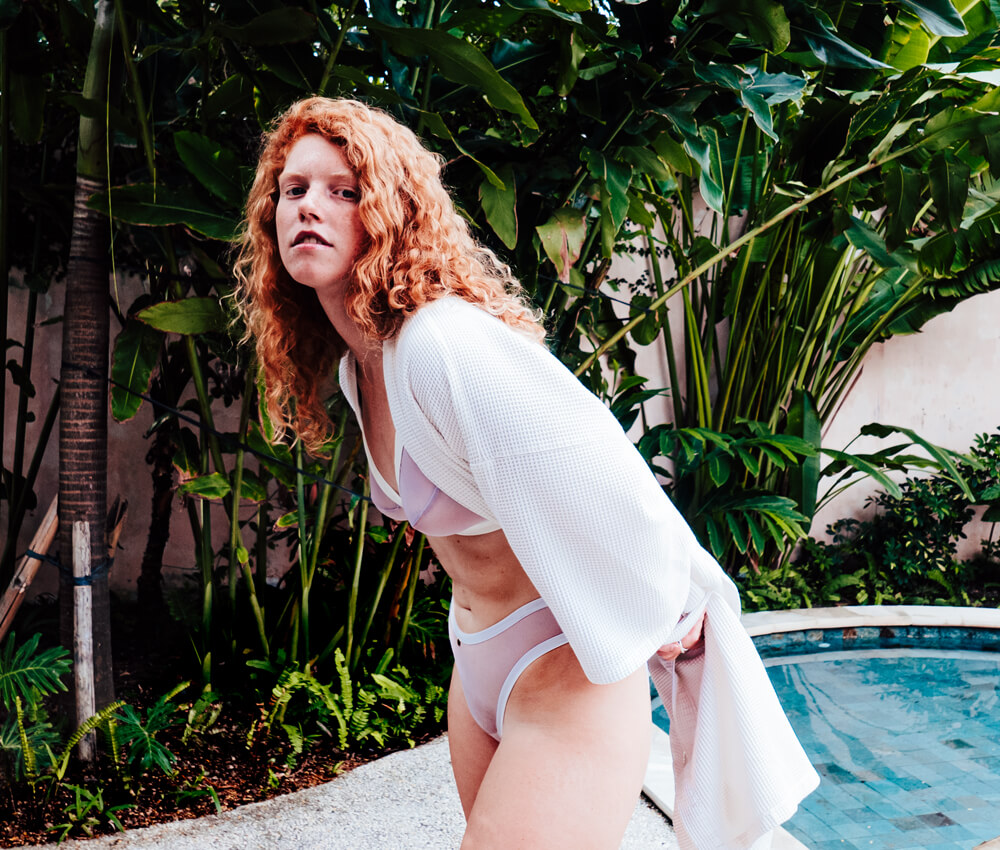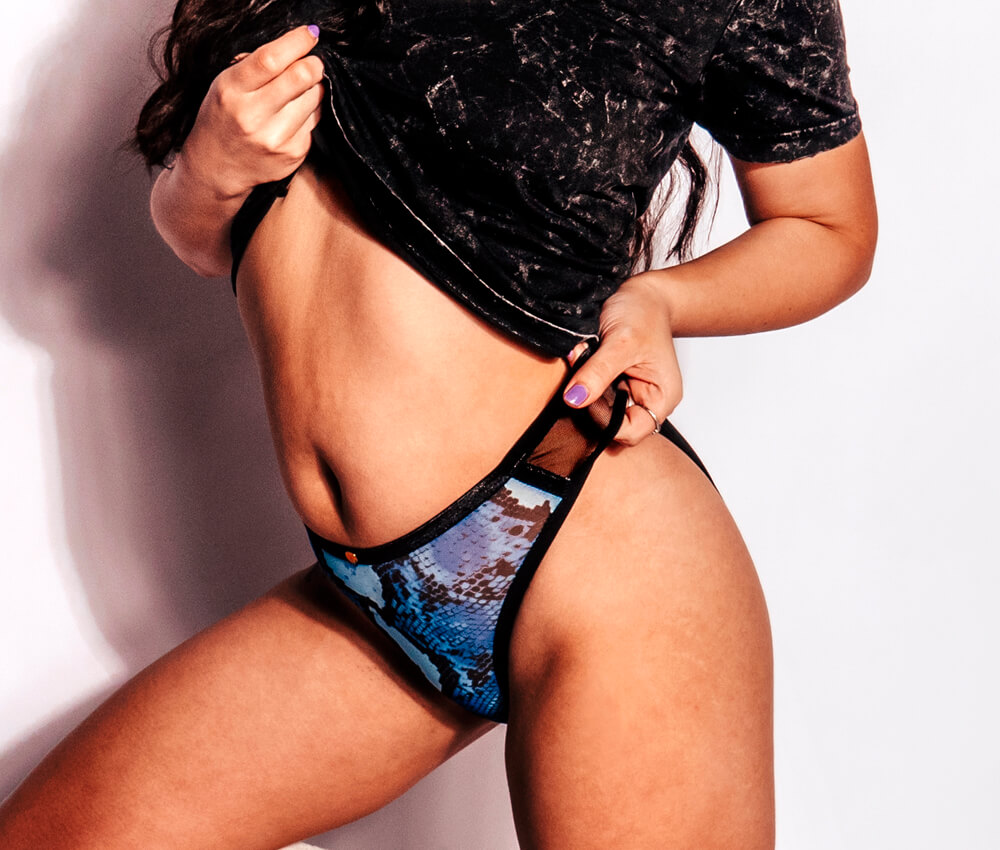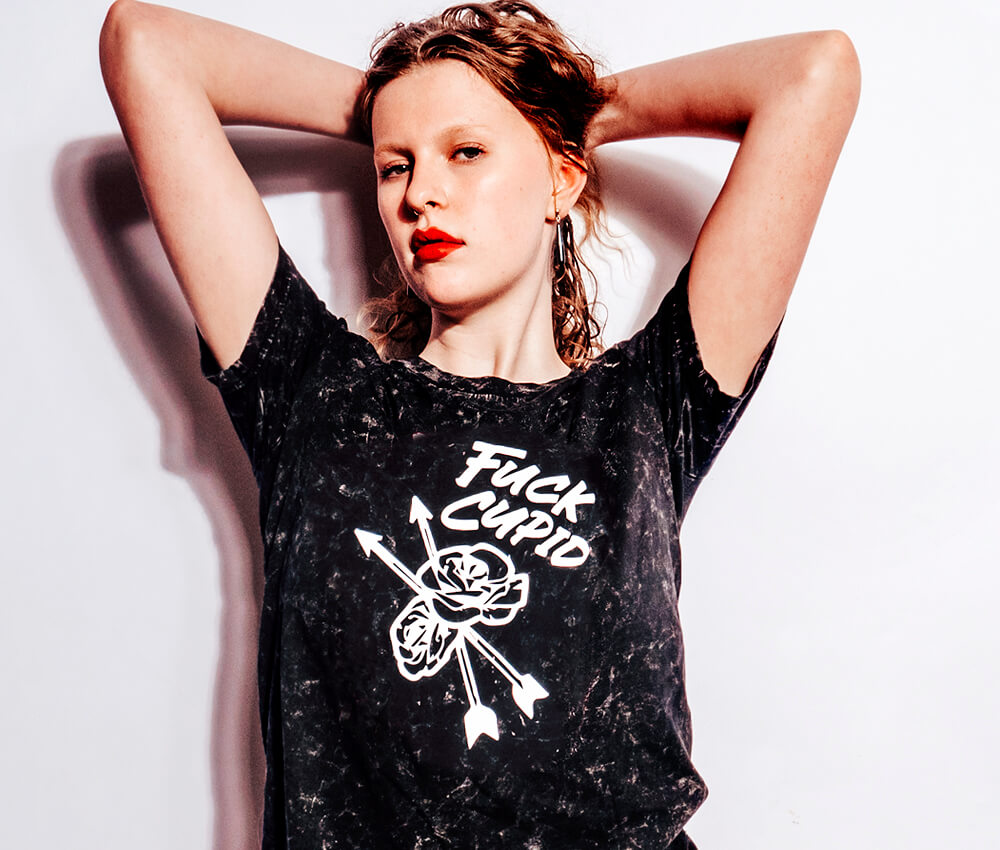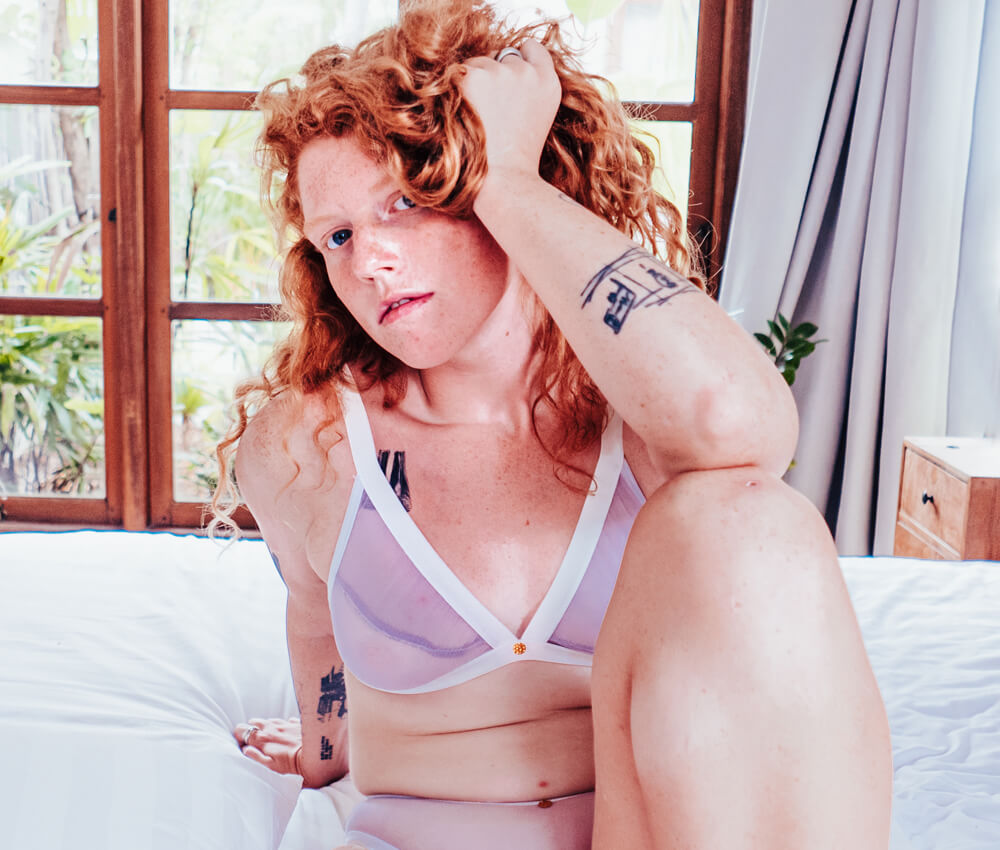Lingerie is a luxurious treat, and choosing the right material can make all the difference in comfort, confidence, and even the environment. So let’s dive into the materials that will keep you feeling good all day long!
THE GOOD
Cotton
Cotton is a popular choice for women’s underwear because of its natural, breathable, and hypoallergenic qualities. It is soft to the touch and gentle on the skin, making it a great choice for everyday wear. The natural fibres of cotton are absorbent, which helps to keep you feeling fresh and dry throughout the day.
Additionally, cotton is easy to care for and long-lasting, so you can enjoy your favourite cotton lingerie for years to come. Whether you prefer classic briefs, comfy boy shorts, or lacy thongs, cotton is a versatile and reliable choice for all your lingerie needs.
Is it environmentally-friendly?
Cotton is a natural fiber that’s breathable, soft, and hypoallergenic. It’s made from the fibers of the cotton plant and is a renewable resource. Cotton is grown in many countries around the world and requires a large amount of water and pesticides to produce, which can have a negative impact on the environment. However, organic cotton production is becoming more popular, which can help mitigate some of these negative impacts.
Pro tip
Cotton underwear doesn’t have to be boring. To spice up your cotton underwear collection, opt for trendy styles with a modern fit.
Organic Cotton
Organic cotton benefits your health. Notably so, there are no chemical retentions in organic cotton clothing. This ensures that people with allergies or with specific chemical sensitivity will greatly benefit from wearing organic cotton and hopefully eliminate any allergic reaction from wearing synthetic textiles.
Garments made of organic cotton breathe much better than synthetic fabrics and feel great to wear, but they also absorb sweat and other toxins from your body, not giving them a chance to hang around. Because of this, it helps to avoid certain health issues like yeast infections and bacteria growth. The best way you can look after yourself down there and avoid build-up of bad bacteria is to let yourself breathe. I guess you could say it’s almost as good as not wearing any underwear at all!
Is it environmentally-friendly?
The most environmentally-friendly underwear option is to go commando. If that’s not your thing, organic cotton is a good runner up.
Pro tip
Make sure your cotton undies have a bit of stretch. This will ensure a bitter fit.
Bamboo
Light, silky-soft and gentle on the skin, bamboo fabric is the comfiest choice for undies, especially since this fabric makes the underwear thermoregulating – meaning it’ll feel cool in summer and cosy in winter. Plus, with its anti-static benefits, you can say no to clinging.
Another reason many people opt for bamboo when it comes to their undies is that it’s a healthier choice. Bamboo contains an antibacterial and anti-fungal bio-agent which also makes bamboo clothing odour-resistant. An essential when it comes to underwear! Bamboo fibres also contain micro-gaps which pull moisture away from the body, making it a moisture-wicking fabric.
Bamboo is often blended with other materials, like spandex or cotton, to add stretch and flexibility, making it a great choice for all-day wear. Whether you prefer a silky smooth chemise, a comfortable bralette, or lacy panties, bamboo is a luxurious and eco-friendly choice for women’s lingerie.
Is it environmentally-friendly?
Thanks to advancements in textile processing and increasingly eco-friendly technologies, it’s possible for bamboo to be transformed into as delicate yarn. This fabric is one of the softest in the world and often said to be on par with, if not better than, silk (as well as much more affordable!).
Bamboo is a sustainable and eco-friendly alternative to cotton, with a silky smooth texture that feels like a dream against your skin. Bamboo is a fast-growing and highly renewable plant, which makes it a great choice for environmentally conscious consumers. Bamboo is processed into a soft, natural fibre that is naturally moisture-wicking and anti-bacterial, making it a great choice for lingerie that feels as good as it looks.
Pro tip
The thickness of bamboo fabrics varies greatly from one brand to another, so it might take a few tries to find the right underwear for you.
Nylon Mesh
Coming with many benefits, these include its stretch, comfort, durability, easy care, and stain resistance were all seen as great benefits. Lingerie mesh is commonly used in panties, creating breathable, light and sheer panels. It is a light and delicate fabric that does not add much bulk, and can be used to provide light linings in bralettes, nighties, or panties.
It can also be used to back lace, to maintain a sheer look while giving more strength and stability. Oh, and not forgetting to mention that the feeling of nylon resembles silk!
Nylon also has more stretch to it and is long-lasting, so lingerie pieces of this fabric will mean that you get your money’s worth. Stretch gives it an extra boost of flexibility, making it a great choice for lingerie that hugs your curves just right.
A breathable fabric wicks away moisture to keep the chest area cool and comfortable. Our bodies eliminate toxins in sweat, so trapping that all inside a sweaty bra isn’t just uncomfortable, but unhealthy.
Nylon mesh comes in 2 main types: two-way stretch and 4-way stretch.
Is it environmentally-friendly?
It is made from a synthetic fibre called nylon, which is not biodegradable and can contribute to microplastic pollution in the environment. However, recycled and biodegradable options are becoming more widely available, making mesh a more eco-friendly choice. At Rock & Lola, we use rescued deadstock mesh fabrics that would have otherwise ended up in landfill, making it an eco-conscious choice.
One great thing about nylon mesh is its durability. With proper care, it will last you a long time.
Stretch Lace
Lace is a delicate and beautiful material that adds a touch of luxury to any lingerie set. Stretch lace is a combination of lace and spandex, making it stretchy and comfortable for all-day wear.
Is it environmentally-friendly?
It is typically made from synthetic fibers, which can have a negative impact on the environment. However, recycled and biodegradable options are becoming more widely available, making stretch lace a more eco-conscious choice.
Modal
Modal is a type of rayon, a semi-synthetic fiber made from natural materials like beech trees. It is soft, smooth, and has a luxurious feel, making it a great choice for lingerie.
Is it environmentally-friendly?
Modal is more environmentally friendly than synthetic fibres like polyester , as it is biodegradable and requires less water and energy to produce. It’s by no means completely natural, though, and it’s classified as a semi-synthetic fibre.
Pro tip
Choose modal if you want to give your underwear basics some extra oomph.
THE NOT-SO-GOOD
Polyester
The Devil wears polyester. That’s what we say here at Rock & Lola.
Polyester is a synthetic, durable, and wrinkle-resistant fabric commonly used in both upmarket and value lingerie. It is known for its ability to retain its shape and colour, making it a popular choice for lingerie that requires a smooth and polished look. It’s often used in shapewear.
Here is the thing, though. Polyester is inexpensive, which makes it a cheap option for lingerie manufacturers. Polyester is not as breathable as natural fibres, which can make it uncomfortable to wear for extended periods of time, especially in intimate clothing. In fact, it feels quite yucky and makes you sweat – a lot! What’s more is that it usually smells awful, especially when it’s new.
Polyester is commonly used for sports bras and other activewear due to its durability and moisture-wicking properties.
The synthetic fibres in polyester are able to wick sweat away from the skin, keeping the wearer dry during physical activity. Polyester’s resistance to stretching and shrinking also makes it a popular choice for sports bras, as it helps to maintain the bra’s shape and support throughout intense movement.
However, it is important to note that while polyester may be effective in wicking moisture, it is not as breathable as natural fibres, which can lead to increased skin irritation and discomfort during extended periods of physical activity. It’s also far from ideal if you’re prone to yeast infections and UTis.
Is it environmentally-friendly?
Polyester is made from petroleum-based materials, and the production process releases harmful chemicals into the environment. When polyester lingerie is disposed of, it can take hundreds of years to degrade in a landfill. To minimize the environmental impact of polyester lingerie, it is important to consider sustainable alternatives, such as organic cotton or recycled materials, and to properly dispose of polyester lingerie after use.
Pro tip
Lorem ipsum dolor sit amet, consectetur adipiscing elit. Ut elit tellus, luctus nec ullamcorper mattis, pulvinar dapibus leo.
Tulle
Tulle is a lightweight, fine mesh fabric made from polyester. It is characterised by its delicate, airy appearance and its crisp, stiff texture.
Tulle is not stretchy, which makes it a popular choice for creating full, voluminous skirts and dresses. However, this stiffness also means that tulle is not particularly comfortable to wear, especially when used in tight-fitting garments.
Tulle is often used for sexy lingerie and dancewear, where its delicate appearance qualities make it a popular choice. However, it is important to note that tulle is not the most practical fabric for everyday wear, as it is prone to snagging and tearing.
Is it environmentally-friendly?
The production and disposal of tulle can have negative impacts on the environment. Synthetic tulle fabrics are made from petroleum-based materials, which contribute to the depletion of non-renewable resources and have a high carbon footprint.
Additionally, the production process for synthetic tulle releases harmful chemicals into the environment, which can have negative impacts on air and water quality. When tulle is disposed of, it can take hundreds of years to degrade in a landfill, contributing to the accumulation of waste and pollution.
Furthermore, tulle is often produced in mass quantities for the fashion and costume industries, leading to overconsumption and waste. To minimize the environmental impact of tulle, it is important to consider sustainable alternatives, such as organic cotton or recycled materials, and to properly dispose of tulle after use.
Pro tip
Some upmarket designer brands use tulle because it is very sheer in appearance. You’ll look damn sexy, but you’ll feel like you have sandpaper rubbing against your sensitive bits, so it’s not a good option in our humble opinion. Nylon mesh is much better choice.
With all of that being said, there are many great options here, but what’s your pick of the bunch?











